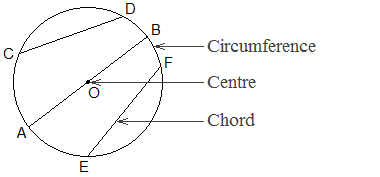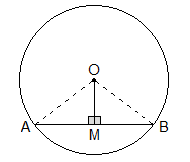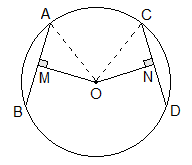Circle Theorems on Chords

A circle is a closed plane figure bounded by a curved line at an equal distance from a fixed point. The fixed point is called the centre of the
circle and the curved line is called the circumference of the circle. A chord
is a line segment joining any two points on the circumference. A chord passing
through the centre of a circle is called the diameter. The diameter is one of the longest chords.

There are certain properties of chords which are stated as the circle
theorems on chords. Following are the circle theorems on chords and their proofs:
THEOREM 1:
“The perpendicular drawn from the centre of a circle to a chord bisects the chord.”
Proof:
Given: O is the centre of a circle and OM is perpendicular to chord AB.
To Prove: AM = BM
Construction: OA and OB are joined.

Proof:
Statements Reasons
1. In DAOM
and DBOM
i.
∠AMO = ∠BMO (R) ----> Both right angles; OM⊥AB
ii. OA = OB (H) -----> Radii of the same circle
iii.
OM = OM (S) ----->
Common side
2. DAOM ≅DBOM -----> By RHS axiom
3. AM = BM ----> Corresponding sides
Proved.
CONVERSE OF THEOREM 1:
“A straight line joining the centre of circle and mid-point of a
chord is perpendicular to the chord.”
Proof:
Given: O is the centre of a circle and OM is perpendicular to chord AB.
To Prove: OM⊥AB
Construction: OA and OB are joined.

Proof:
Statements Reasons
1. In DAOM
and DBOM
i.
OA = OB (S) ----> Both
right angles; OM⊥AB
ii.
AM = BM (S) ----> Radii
of the same circle
iii.
OM = OM (S) ---->
Common side
2. DAOM ≅DBOM ----> By RHS axiom
3. ∠AMO = ∠BMO ----> Corresponding
angles
4. ∠AMO + ∠BMO = 180° ----> Linear
pair of angles
or, ∠AMO + ∠AMO = 180°
or, 2∠AMO = 180°
or, ∠AMO = 90°
5. OM⊥AB ----> Being ∠AMO = 90°
Proved.
THEOREM 2:
“The perpendicular bisector of the chord of a circle passes
through the centre.”
This theorem can be verified by an experiment. Here is the experimental
verification of the theorem:
Construction: By using a scale, pencil and compass, three circles of
different radii are drawn. Perpendicular bisectors of chords AB and CD are
drawn which meet at O. In each figure O is joined with A, B, C and D.

Now, the measures of OA, OB, OC, and OD are tabulated below:
Table:

Conclusion: OA = OB = OC = OD shows that O is the centre of the circle.
Hence, it is experimentally verified that the perpendicular bisector of the
chord of a circle passes through the centre.
THEOREM 3:
“Equal chords of a circle are equidistant from the centre of the
circle.”
Proof:
Given: O is the centre of the circle, where chord AB = chord CD. OM
and ON are drawn perpendicular to AB and CD respectively.
To Prove: OM = ON
Construction: OA and OC are joined.

Proof:
Statements Reasons
1. AM = AB/2 and CN = CD/2 -----> Perpendicular bisect the chord.
2. AB = CD -------> By given
3. AM = CN -------> From statements 1 and 2
4. In DAMO
and DCNO
i.
∠AMO = ∠CNO (R) -----> Both are right angles
ii.
OA = OC (H) ----->
Radii of the same circle
iii.
AM = CN (S) -----> From
statement 3.
5. DAMO ≅DCNO -----> By RHS axiom
6. OM = ON ---------------------> Corresponding sides
Proved.
CONVERSE OF THEOREM 3:
“Chords which are equidistant from the centre of a circle are
equal.”
Proof:
Given: O is the centre of a circle and OM is perpendicular to chord AB.
To Prove: AM = BM
Construction: OA and OB are joined.

Proof:
Statements Reasons
1. In DAMO
and DCNO
i.
∠AMO = ∠CNO (R) ----> Both right angles
ii.
OA = OC (H) ----->
Radii of same circle
iii.
OM = ON (S) -----> Given
2. DAMO ≅DCNO -----> By RHS axiom
3. AM = CN -----> Corresponding sides
4. AM = AB/2 and CN = CD/2 ----> Perpendicular bisect the chord
5. AB = CD ----> From statement 3 and 4
Proved.






Post a Comment
0 Comments